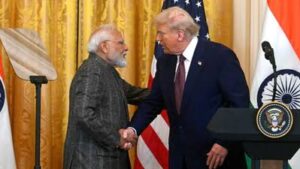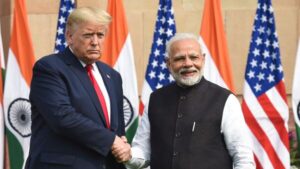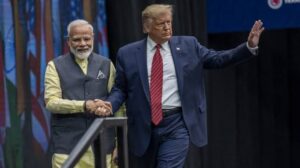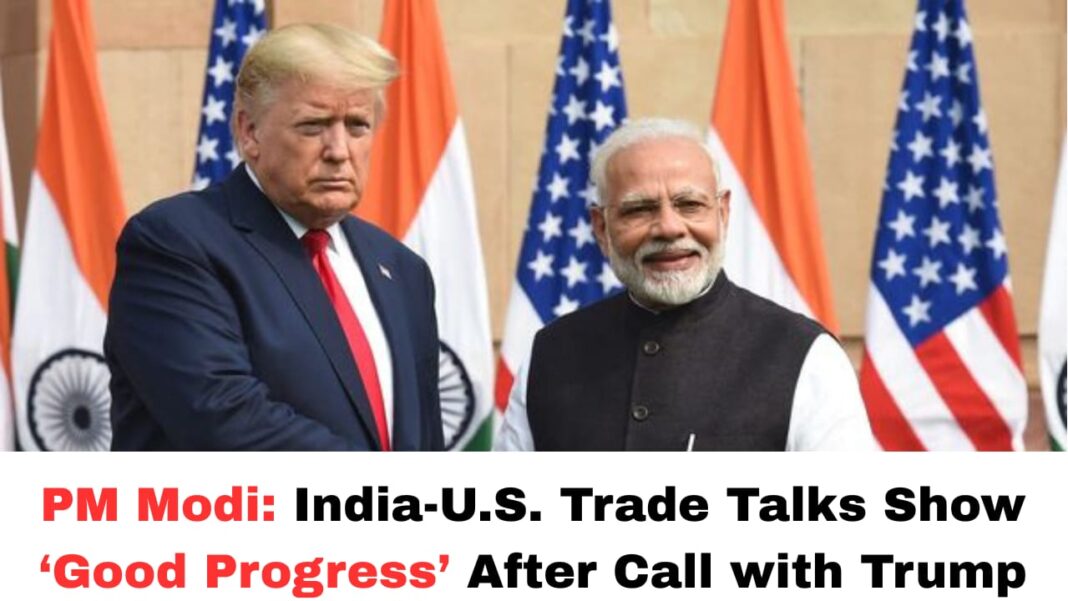Digital News Guru National Desk:
PM Modi Says Trade Talks with Trump Making “Good Progress”
Prime Minister Narendra Modi announced on October 9, 2025, that he had a telephone conversation with U.S. President Donald Trump during which the two leaders “reviewed good progress achieved in trade negotiations.”
Modi also congratulated Trump on the success of the first phase of his Gaza peace plan in the same call.
Both leaders “agreed to stay in close touch over the coming weeks,” reinforcing that the talks are active and ongoing.

Context & Stakes
- Trade Tensions & Tariffs
The backdrop to this development is a period of high tension between India and the U.S. Earlier, the Trump administration had imposed reciprocal tariffs of up to 50% on a broad range of Indian exports, including gems & jewelry, textiles, and seafood.
These tariffs had dented exports from labor-intensive sectors, putting pressure on India to negotiate.
The trade negotiation represents a critical opportunity for India to resolve or mitigate these tariff issues, ideally in a manner that protects its export interests.
- Recent Diplomatic Moves
The call comes amid recent rounds of trade talks. An Indian delegation led by Commerce Minister Piyush Goyal traveled to Washington for discussions, and trade officials from the U.S. Trade Representative’s office have been engaging with their Indian counterparts.
The renewed engagement signals that both sides want to stabilize the bilateral economic relationship.
- Link with Global & Regional Issues
The call also came in the context of global turbulence in the Middle East. By coupling the congratulations on the Gaza plan with trade discussions, Modi appears to be blending diplomatic signaling with economic priorities.
India is walking a fine balancing act: maintaining strategic autonomy while keeping key partnerships intact.
What “Good Progress” Could Mean
When Modi describes the negotiations as making “good progress,” it could imply several things:

- Concessions or compromises on tariffs: Either side may be more willing to adjust tariff lines or consider phased reductions.
- Sectoral carve-outs: Sensitive sectors (textiles, gems, etc.) might see special treatment or protection in a new deal.
- Trade facilitation & non-tariff barriers: Beyond tariffs, things like customs, standards, intellectual property, and digital trade may be under negotiation.
- Interim/minimal agreement: A partial or “mini deal” might be crafted first, before a full comprehensive agreement.
- Strong political buy-in: The direct calls between heads of government suggest political will at the highest level, rather than just bureaucratic engagement.
However, “good progress” is still vague. The real test will be in the details—what’s agreed, what’s binding, and how quickly implementation follows.
Challenges & Roadblocks
Even if momentum is positive, several challenges lie ahead:
- Domestic pressures: Indian exporters and industry bodies will watch closely to ensure that trade concessions don’t harm local competitiveness.
- Reciprocity vs fairness: India will likely resist overly harsh reciprocity clauses that could erode gains or hurt key sectors.
- Implementation & enforcement: Agreements are only as good as their execution, dispute resolution mechanisms, and oversight.
- Geopolitical risks: U.S. policy changes, sudden shifts in market conditions, or regional instability could derail momentum.
- Balancing multiple relationships: India is simultaneously engaging with China, Russia, Europe, and others, so it must maintain flexibility.
What to Watch
- Next round of talks: Officials from both sides have hinted that another round is underway soon, possibly in India or the U.S.
- Sectoral outcomes: Whether textiles, gems & jewelry, defense goods, or agriculture get special carve-outs.
- Tariff rollback or phased cuts: Especially on those goods where U.S. trade officials have raised objections.

- Role of energy & investment: As India seeks greater U.S. energy imports (e.g. LPG, crude), trade talks may intersect with energy diplomacy.
- Public statements & leaks: As talks proceed, leaks or public disclosures may reveal which elements are sticking or stalling.
Bottom Line
Prime Minister Modi’s statement about “good progress” in trade talks with President Trump suggests optimism on both sides that a constructive outcome is possible. But the phrase also masks complexity: negotiations of this scale involve detailed tradeoffs, sectoral sensitivities, and political constraints.
If handled well, the deal could ease tariff tensions, boost bilateral trade, and provide relief to exporters. But success will depend not just on agreement, but on how swiftly and fairly it is implemented.
You May Also Read: India Seeks U.S. LPG Imports — Tender Deadline Extended to Oct 17








